Metz Company on:
[Wikipedia]
[Google]
[Amazon]
The Metz Company was a pioneer


 In 1913, Metz introduced the Model 22, a two-seat roadster or
In 1913, Metz introduced the Model 22, a two-seat roadster or
File:Gaetano Napoli in his Metz at the 1913 Targa Florio.jpg, alt=, Gaetano Napoli in his Metz at the 1913 Targa Florio
File:1914 Metz 22 Torpedo Roadster (38963819934).jpg, alt=, 1914 Metz 22 Advertisement
File:15608 Grand Canyon Historic Hopi House c. 1914 (5898212764).jpg, alt=, 1914 Metz at Grand Canyon Hopi House
File:1920 Metz Master Six Touring Car (24803922147).jpg, alt=, 1920 Metz Master Six
Classic Speedsters Blog Charles Metz SpeedsterMetz/Waltham Automobiles Blog
brass era
The Brass Era is an American term for the early period of automotive manufacturing, named for the prominent brass fittings used during this time for such things as lights and radiators. It is generally considered to encompass 1896 through 1915 ...
automobile
A car or automobile is a motor vehicle with wheels. Most definitions of ''cars'' say that they run primarily on roads, seat one to eight people, have four wheels, and mainly transport people instead of goods.
The year 1886 is regarded ...
maker established by Charles Herman Metz in Waltham, Massachusetts
Waltham ( ) is a city in Middlesex County, Massachusetts, United States, and was an early center for the labor movement as well as a major contributor to the American Industrial Revolution. The original home of the Boston Manufacturing Company, ...
, from 1909 to 1922.
History
C. H. Metz began in business in 1886 making bicycle parts, and in 1893 formed theWaltham Manufacturing Company
Waltham Manufacturing Company (WMC) was a manufacturer of bicycles, motorcycles, motorized tricycles and quadricycles, buckboards, and automobiles in Waltham, Massachusetts. It sold products under the brand names Orient, Waltham, and Walt ...
with Herbert L. Thompson, Elmer G. Howe and Frank L. Howe. Later the firm developed designs for motorized vehicles. Metz departed his company over disagreements of company direction in 1901. He became the technical editor of the Cycle and Automobile Trade Journal.
Waltham Manufacturing Co. was in financial difficulties and in 1908 C. H. Metz took back control. He reorganized as the Metz Company in 1909.
Kit car
Metz inherited a large stock of automobile parts for the 10-hp runabout designed by William H. Little. Although Metz was not the first to offer a kit car (Dyke andSears
Sears, Roebuck and Co. ( ), commonly known as Sears, is an American chain of department stores founded in 1892 by Richard Warren Sears and Alvah Curtis Roebuck and reincorporated in 1906 by Richard Sears and Julius Rosenwald, with what began a ...
predated Metz with do-it-your-self high-wheelers), Metz did offer the first known kit automobile on the installment plan, known as the Metz Plan. The buyer would buy 14 groups or packages of parts for $27 which would be put together with the plans and tools supplied, for a total price of $378, (). A factory-assembled automobile could be bought for $475. The plan was in effect until 1911 when it became impractical to compete with a dealer-supplied model "T" Ford.
In 1910, the two-cylinder 10-hp Metz was increased to 12-hp. Built on a 81-inch wheelbase
In both road and rail vehicles, the wheelbase is the horizontal distance between the centers of the front and rear wheels. For road vehicles with more than two axles (e.g. some trucks), the wheelbase is the distance between the steering (fron ...
, complete runabouts or special delivery body cars were produced into 1912.
Model 22


 In 1913, Metz introduced the Model 22, a two-seat roadster or
In 1913, Metz introduced the Model 22, a two-seat roadster or torpedo
A modern torpedo is an underwater ranged weapon launched above or below the water surface, self-propelled towards a target, and with an explosive warhead designed to detonate either on contact with or in proximity to the target. Historically, ...
bodied car, with an en-bloc 22½ hp (17 kW) four-cylinder water-cooled engine. The Metz 22 had a 90-inch wheelbase with Bosch magneto
A magneto is an electrical generator that uses permanent magnets to produce periodic pulses of alternating current. Unlike a dynamo, a magneto does not contain a commutator to produce direct current. It is categorized as a form of alternator, ...
, full-elliptic
In mathematics, an ellipse is a plane curve surrounding two focal points, such that for all points on the curve, the sum of the two distances to the focal points is a constant. It generalizes a circle, which is the special type of ellipse in ...
springs front and rear, artillery wheel
The artillery wheel was a nineteenth-century and early-twentieth-century style of wagon, gun carriage, and automobile wheel. Rather than having its spokes mortised into a wooden nave (hub), it has them fitted together in a keystone fashion with m ...
s with Goodrich clincher tires, and featured a Prest-O-Lite-type acetylene
Acetylene ( systematic name: ethyne) is the chemical compound with the formula and structure . It is a hydrocarbon and the simplest alkyne. This colorless gas is widely used as a fuel and a chemical building block. It is unstable in its pure ...
generator for the headlight
A headlamp is a lamp attached to the front of a vehicle to illuminate the road ahead. Headlamps are also often called headlights, but in the most precise usage, ''headlamp'' is the term for the device itself and ''headlight'' is the term for ...
s. It was billed as "gearless", having a friction drive
A friction drive or friction engine is a type of transmission that utilises two wheels in the transmission to transfer power from the engine to the driving wheels. The system is naturally a continuously variable transmission; by moving the two ...
mechanism, and priced at $475, .
Advertisements claimed to be the "winner of the Glidden Tour", due to all 3 of the participating Metz cars receiving a perfect score. In 1914 Metz had a Speedster model added at a price of $500. In 1915, Model 22 became Model 25 with an improved 25-hp engine on a 108-inch wheelbase.Fate
In 1917 Metz added 3 types of light trucks to their car production, but business was curtailed in 1918 due to theWorld War
A world war is an international conflict which involves all or most of the world's major powers. Conventionally, the term is reserved for two major international conflicts that occurred during the first half of the 20th century, World WarI (1914 ...
. The Factory was turned over to war work, but post-war road-blocks caused Metz to never collect $130,000 due from the government. In 1919 Metz fielded a larger car called the Metz Master 6, with a six-cylinder 45-hp engine. This 120-inch wheelbase car, with a price range from $1,895 to $2,895 for an enclosed sedan, did not sell well.
The post-war depression caused a dire financial condition and Metz was taken over by the Waltham National Bank. They reorganized the company and renamed it the Motor Manufacturers Incorporated of Waltham. The Metz Master 6 was renamed the Waltham Six, which sold for $2,450 and was produced in 1922 only. This restructuring attempt failed, and Charles Metz filed for Bankruptcy in August 1922.
See also
Classic Speedsters Blog Charles Metz Speedster
References
{{DEFAULTSORT:Metz Company (Automobile) Brass Era vehicles Defunct motor vehicle manufacturers of the United States 1910s cars Defunct companies based in Massachusetts Companies based in Waltham, Massachusetts Motor vehicle manufacturers based in Massachusetts Cars introduced in 1909 Vehicle manufacturing companies established in 1909 Vehicle manufacturing companies disestablished in 1922 1920s cars Vintage vehicles